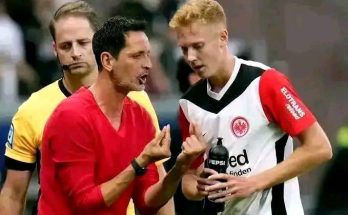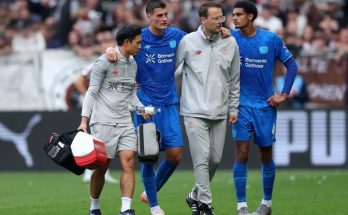The Florida Gators have always prided themselves on keeping elite talent home, and their aggressive pursuit of in-state prospects has been a hallmark of their recruiting philosophy. But sometimes, even with the best intentions and a laser-focused approach, a program’s hunger to stack up blue-chip talent can backfire. That’s exactly what many believe happened in the case of one of Florida’s most highly regarded commitments—an elite cornerback whose unexpected decommitment has sent shockwaves through the college football recruiting world.
The player in question had long been seen as a foundational piece of the Gators’ 2025 class. A homegrown product with blazing speed, fluid hips, and a nose for the football, he represented everything the program looks for in a defensive back. The coaching staff made him a priority early in the process, hosting him for multiple visits and building strong ties with his family. For a while, it looked like Florida had locked down one of the state’s premier talents, with the cornerback even taking on a leadership role among the committed players, helping to recruit others to join him in Gainesville. But all of that changed in an instant when he announced that he was reopening his recruitment.
At first glance, it seemed puzzling. The Gators had done everything right, hadn’t they? They had checked all the boxes, from consistent communication and campus visits to playing time projections and relationship-building. But beneath the surface, there was a more complex dynamic at play—one that may have ultimately tipped the scales toward decommitment. Florida’s unrelenting pursuit of another elite in-state cornerback, a five-star phenom with offers from nearly every Power Five school, appears to have raised eyebrows and planted seeds of doubt.
While college football recruiting is always a competitive arena, few positions see as much overlap and scrutiny as defensive back. Teams are constantly looking for shutdown corners, and with the evolution of spread offenses and vertical passing attacks, having multiple elite DBs is more necessity than luxury. Florida, in its quest to solidify one of the best defensive back groups in the nation, had been aggressively recruiting not just one, but two of the top cornerbacks in the state. On paper, it made sense: secure as much talent as possible and let competition breed excellence. But for the original commit, it may have felt like a shift in trust—a signal that he was no longer the centerpiece, but simply a piece.
There’s also the psychological element to consider. Top-tier recruits, especially those who commit early, often do so with the understanding that they are being prioritized and valued as irreplaceable. When they see the coaching staff flying across the state to visit another prospect at their same position—posting photos, making media rounds, and hyping up the possibility of flipping another five-star talent—it can create a ripple effect of insecurity. These young athletes are not just picking a school; they’re choosing a future, a family, and an identity. Any sign that their role may be diminished can feel like a personal slight.
Sources close to the situation have hinted that the decommitment wasn’t entirely unexpected internally. There had been subtle signs in the weeks leading up to the announcement—missed check-ins, delayed responses, and less enthusiastic social media engagement. And though the coaching staff made efforts to assure the player of their continued commitment, the simultaneous pursuit of the other elite cornerback sent a conflicting message. Recruiting, after all, is as much about perception as it is about performance.
It’s worth noting that this isn’t the first time Florida has faced this type of situation. The program has a rich history of defensive back play, and with that comes high expectations and an ever-present hunger for elite talent. Former head coaches and current staff alike have often walked a tightrope between stockpiling top recruits and maintaining the trust of those already in the fold. This case serves as a reminder that even the most well-intentioned strategies can have unintended consequences.
From a broader perspective, the situation underscores the evolving landscape of modern recruiting. With NIL deals, social media branding, and player empowerment at an all-time high, athletes are more informed and sensitive than ever before. They understand their value, and they expect transparency. When commitments feel transactional or conditional, the likelihood of decommitments rises. In this case, the Gators’ strategy may have come across as hedging their bets rather than doubling down on their initial choice.
This decommitment is undoubtedly a blow to Florida’s 2025 class, at least in the short term. The player was not just a highly rated recruit, but also a key figure in the Gators’ broader recruiting efforts. Losing him means not only a hit to their on-field potential, but also a possible domino effect among other targets. Momentum is a fragile thing in the recruiting world, and any perceived instability can lead rival programs to pounce.
Still, it would be premature to declare this a recruiting failure. Florida remains firmly in the race for both the original commit—who has not ruled out a return to Gainesville—and the other top cornerback they’ve been pursuing. If the Gators can manage to land one or both, the narrative could quickly flip back in their favor. But it will require delicate maneuvering, honest conversations, and perhaps most importantly, a recalibration of how they balance ambition with loyalty.
It’s also a lesson in communication. If the coaching staff had more clearly communicated their intentions—framing the dual pursuit as a chance to build a “no-fly zone” rather than potentially replacing one with another—the outcome might have been different. Recruits talk, compare notes, and follow each other’s journeys closely. A transparent approach, emphasizing partnership and positional camaraderie, can help soften the edges of what might otherwise feel like a betrayal.
As for the player himself, he’s suddenly one of the hottest uncommitted names on the market again. Powerhouse programs from across the country are expected to ramp up their interest, seeing an opening where Florida once stood strong. The decommitment not only re-energizes his recruitment, but also allows him to revisit his priorities, reassess relationships, and determine which school truly sees him as the cornerstone he believes he is.
Ultimately, this saga is a microcosm of the push-and-pull that defines elite-level recruiting. Programs like Florida operate under immense pressure to win—and to win now. That pressure drives them to pursue the best of the best, sometimes without fully appreciating the emotional and psychological toll that approach can take on young athletes. The line between confidence and overreach is thin, and in this case, it may have been crossed.
In the coming weeks and months, all eyes will be on both Florida and the cornerback they lost. Will he find a new home that gives him the clarity and commitment he’s looking for? Will Florida double down on their pursuit of the other top prospect, or attempt to repair the relationship and win back the player they once had in hand? And most importantly, will this serve as a turning point in how the Gators approach their in-state recruiting battles?
Only time will tell. But one thing is certain: the road to signing day is long, winding, and filled with twists. For Florida, this latest bump in the road is a reminder that in the world of recruiting, talent acquisition is just as much about managing relationships as it is about scouting ability. The pursuit of greatness comes with risks, and sometimes, those risks mean losing a prized commit in the process.



